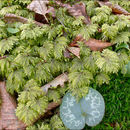More info for the terms:
cover,
frequency,
shrubsSplendid feather moss is abundant and often dominant in coniferous forests on water-shedding and water-receiving sites [
18]. On such sites, this moss often develops a mat layer that may be 7.9 to 11.8 inches (20-30 cm) thick [
28]. Splendid feather moss also occurs on ledges, humus and decaying wood in cool, moist ravines and mountain woods from sea level to 10,000 feet (0-3,048 m) [
14]. This moss is a common moss on dune pastures in Scotland [
25]. Splendid feather moss is restricted to areas sheltered by trees and shrubs [
7]. It requires shade, moderate water levels, and high nutrient levels. It is not rooted in the substrate and is nearly independent of the substrate's nutrient and water supply. Growth is controlled by rainfall frequency and degree of protection from evaporation stress [
7]. This moss quickly dries up when the canopy cover is not adequate to prevent high evaporation [
17]. Growth rates are highest in habitats protected from evaporation stress, and survival is enhanced in shaded habitats or in environments with high humidity and consistent cloud cover [
7]. Splendid feather moss is typically found associated with the following understory species: salal (Gaultheria shallon), pachystima (Pachystima myrsinites), Shreber's moss (Pleurozium schreberi), Rhytidiadelphus boreus, big huckleberry (Vaccinium membranaceum), and red huckleberry (V. parvifolium) [
18].

